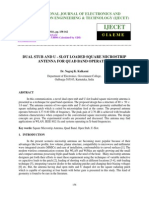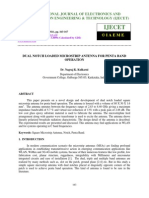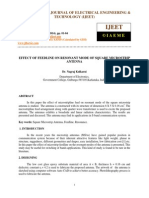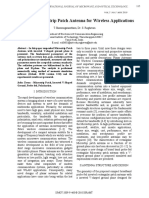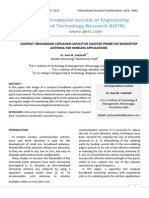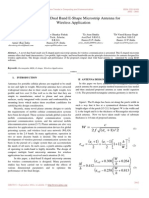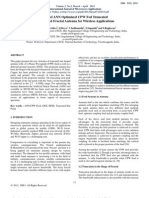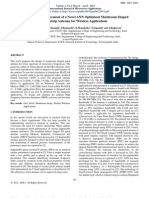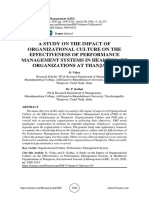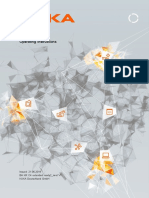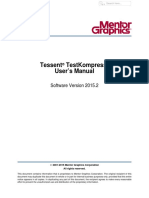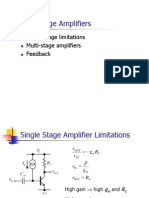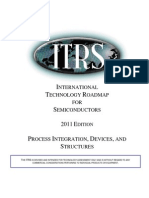Ijaret: ©iaeme
Ijaret: ©iaeme
Uploaded by
IAEME PublicationCopyright:
Available Formats
Ijaret: ©iaeme
Ijaret: ©iaeme
Uploaded by
IAEME PublicationOriginal Title
Copyright
Available Formats
Share this document
Did you find this document useful?
Is this content inappropriate?
Copyright:
Available Formats
Ijaret: ©iaeme
Ijaret: ©iaeme
Uploaded by
IAEME PublicationCopyright:
Available Formats
International Journal of Advanced Research in Engineering RESEARCH and Technology IN (IJARET), ISSN 0976 INTERNATIONAL JOURNAL OF ADVANCED ENGINEERING
G 6480(Print), ISSN 0976 6499(Online) Volume 5, Issue 2, February (2014), pp. 168-172, IAEME AND TECHNOLOGY (IJARET)
ISSN 0976 - 6480 (Print) ISSN 0976 - 6499 (Online) Volume 5, Issue 2, February (2014), pp. 168-172 IAEME: www.iaeme.com/ijaret.asp Journal Impact Factor (2014): 7.8273 (Calculated by GISI) www.jifactor.com
IJARET
IAEME
A NOVEL U-SLOT CIRCULAR MICROSTRIP ANTENNA FOR TRIPLE BAND OPERATION
Dr. Nagraj K. Kulkarni Government College, Gulbarga-585105, Karkataka, India
ABSTRACT In this communication a novel design and development U slot loaded circular microstrip antenna is presented for triple band operation. The antenna has a volume of 8 X 5 X 0.16 cm3 and operates between the frequency range of 5.57 to 8.34 GHz giving a maximum impedance bandwidth of 10.34 % with a peak gain of 1.85 dB. The simple commercially available glass epoxy substrate material is used to fabricate the antenna. The microstripline feed arrangement is incorporated to excite the antenna. The antenna shows linearly polarized broadside radiation characteristic. The design detail of the antenna is described. The experimental results are presented and discussed. This antenna may find applications for systems operating in C and X-band frequencies. Keywords: Circular Microstrip Antenna, Slits, Triple Band. 1. INTRODUCTION The modern communication systems are requiring the compact and multi featured antennas. The microstrip antennas have become attractive candidates to suit the need of the hour in handling the transmit/receive action in emerging communication applications like WLAN, WiMax and HIPERLAN/2, 3G-4G mobile systems, because of their numerous inherent features like low profile, low fabrication cost, ruggedness, planar configuration, light weight, integrability with MMICs and ease of installation [1]. The triple and multiple band antennas are realized by many methods such as, slot on the patch, arrays, use of stubs and shorts, various shapes of meander slots [2-5] etc. But in this study a simple circular microstrip antenna with U shaped slot placed at the center of the patch is used to achieve triple band operation. This kind of antenna structure is found to be rare in the literature.
168
International Journal of Advanced Research in Engineering and Technology (IJARET), ISSN 0976 6480(Print), ISSN 0976 6499(Online) Volume 5, Issue 2, February (2014), pp. 168-172, IAEME
2. ANTENNA DESIGN The low cost commercially available glass epoxy substrate material of thickness h = 0.16 cm and r = 4.2 is used to fabricate the conventional circular microstrip antenna (CCMSA) and U slotloaded circular microstrip antenna (UCMSA). The art work of proposed antennas is sketched using auto-CAD software to achieve better accuracy. The antennas are etched using the photolithography process.
Figure 1: Top view geometry of CCMSA Figure 1 shows the top view geometry of CCMSA. The radiating patch radius R is designed for the resonant frequency of 3.5 GHz, using the basic equations available in the literature [6]. A quarter wave transformer of length Lt and width Wt is used between lower semicircle of the patch and microstripline feed of length Lfeed and width Wfeed for matching their impedances. A semi miniature-A (SMA) connector of 50 impedance is used at the tip of the microstripline to supply the microwave power.
Figure 2: Top and bottom view geometry of UCMSA
169
International Journal of Advanced Research in Engineering and Technology (IJARET), ISSN 0976 6480(Print), ISSN 0976 6499(Online) Volume 5, Issue 2, February (2014), pp. 168-172, IAEME
Figure 2 shows the top and bottom view geometry of UCMSA. The U shaped slot of horizontal and vertical arm lengths h and v is placed at the center of the radiating patch. The H shaped slot of width 1 mm having horizontal and vertical arm lengths Hh and Hv is placed on the ground plane such that the middle point of this slot coincides with the center of the radiating patch. The dimensions R, h, v, Hh and Hv are taken in terms of 0 , where 0 is a free space wave length in cm corresponding to the designed frequency of 3.5 GHz. Table 1 gives the design parameters of the CCMSA and UCMSA. Table 1: Design parameters of the CCMSA and UCMSA Antenna CCMSA UCMSA R 1.227 1.227 Lfeed 2.18 2.18 Wfeed 0.32 0.32 Lt 1.097 1.097 Wt 0.07 0.07 A 5 5 B 8 8 H 0/10 v 0/2 Hh 0/5 Hv 0/2
3. RESULTS AND DISCUSSION Vector Network Analyzer (The Agilent N5230A: A.06.04.32) is used to measure the experimental return loss of CCMSA and UCMSA. Figure 3 shows the variation of return loss versus frequency of CCMSA. From this figure it is seen that, the CCMSA resonates at 3.31 GHz of frequency which is close to the designed frequency of 3.5 GHz. The experimental bandwidth is calculated using the formula,
Bandwidth (%) =
f 2 f1 100 fc
where, f2 and f1 are the upper and lower cut off frequencies of the resonated band when its return loss reaches -10dB and fc is a centre frequency between f1 and f2. The bandwidth of CCMSA is found to be 3.0 %.
Figure 3: Variation of return loss versus frequency of CCMSA
170
International Journal of Advanced Research in Engineering and Technology (IJARET), ISSN 0976 6480(Print), ISSN 0976 6499(Online) Volume 5, Issue 2, February (2014), pp. 168-172, IAEME
Figure 4: Variation of return loss versus frequency of UCMSA Figure 4 shows the variation of return loss versus frequency of UCMSA. It is clear from this figure that, the antenna operates for three bands BW1 = 10.34 % (5.59-6.20 GHz), BW2 = 4.91% (6.94-7.29 GHz) and BW3 = 6.69 % (7.8-8.34 GHz) for the resonating modes of f1, f2 and f3 respectively. The BW1 is due to the fundamental resonance of the patch. The bands BW2 and BW3 are due to the U shaped slot present on the radiating patch. Further it can be noted that, the insertion of the H shaped slot on the ground plane helps to give the frequency ratio f2/f1 of about 1.206, which indicates the flexibility to design dual and triple bands.
Figure 5: Radiation pattern of UCMSA measured at 5.895 GHz The far field co-polar and cross-polar radiation patterns of the proposed antenna is measured in its operating band. The typical radiation pattern of UCMSA measured at 5.895 GHz is shown in Fig. 5. From this figure it is observed that, the pattern is broadsided and linearly polarized. The gain of the proposed antenna is calculated using absolute gain method given by the relation,
0 G (dB) = 10 log Pr - (Gt) dB - 20 log dB Pt 4R
( )
where, Pt and Pr are transmitted and received powers respectively. R is the distance between transmitting antenna and antenna under test. The peak gain of UCMSA measured in BW1 is found to be 3.14 dB.
171
International Journal of Advanced Research in Engineering and Technology (IJARET), ISSN 0976 6480(Print), ISSN 0976 6499(Online) Volume 5, Issue 2, February F (2014), pp. 168-172 2, IAEME
4. CONCLUSION From this study it is concluded that, UCMSA gives triple bands between 5.57 to 8.34 GHz with a maximum bandwidth of about 10.34 % and a frequency ratio of 1.206. The antenna exhibits broadside radiation characteristics with a peak gain of 1.85 dB. The proposed antenna uses low cost substrate material with simple design and fabrication. This antenna may find applications for systems operating in C and X-band frequencies. REFERENCES 1. Constantine A. Balanis,Antenna theory : analysis and design, John Wiley, New York, (1997). 2. Girish Kumar and K. P. Ray, Broadband microstri Antennas, Artech House, Boston, London, 2003. 3. S. V. Shynu, G. Augastin, C. K. Aanandan, P. Mohanan and K. Vasudevan, C- shaped slot loaded reconfigurable microstrip antenna, Electron Lett. 42(2006), 316-318. 4. S. T. Fang and K. L. Wong, A dual frequency equilateral triangular microstrip antenna with a pair of narrow slots, Microwave Optical Technology Letters, Vol. 23, pp. 82 82-84, 1999. 5. J. H. Lu and K. L Wong Slot Loaded meandered rectangular microstrip antenna With Compact dual - frequency operation, Electronic Letters, Vol. 34, pp. 1048- 1050, 1998. 6. Bahl, I. J. and P. Bhartia, Microstrip Antennas, Artech house, New Delhi, 1980. 7. M. Veereshappa and Dr.S.N Mulgi, Corner Truncated Rectangular Slot Loaded Monopole Microstrip Antennas for Quad Quad-Band Operation, International Journal of Electronics and Communication Engineering & Technology (IJECET), (IJECET), Volume 4, Issue 2, 2013, 20 pp. 165 - 171, ISSN Print: 09760976 6464, ISSN Online: 0976 6472. 8. Nagraj Kulkarni and S. N. Mulgi, Corner Truncated Inverted U - Slot Triple Band Tunable Rectangular Microstrip strip Antenna for Wlan Applications, Applications International Journal of Electronics and Communication Engineering & Technology (IJECET), (IJECET), Volume 3, Issue 1, 2012, pp. 1 - 9, ISSN Print: 0976- 6464, ISSN Online: 0976 6472. 9. Gangadhar P Maddani, Sameena N Mahagavin and Shivasharanappa N Mulgi Mulgi, Rectangular Microstrip Array Antennas For Wide Triple Band Operation, Operation International Journal of Electronics and Communication Engineering & Technology (IJECET), (IJECET), Volume 1, Issue 1, 2010, pp. 53 - 61, , ISSN Print: 09760976 6464, ISSN Online: 0976 6472.
BIO-DATA Dr. Nagraj K. Kulkarni received his M.Sc, M.Phil and Ph. D degree in Applied Electronics from Gulbarga University Gulbarga in the year 1995, 1996 and 2014 respectively. He is working as an Assistant professor and Head, in the Department of Electronics Government Degree College e Gulbarga. He is an active researcher in the field of Microwave Electronics.
172
You might also like
- Ijaret: ©iaemeDocument5 pagesIjaret: ©iaemeIAEME PublicationNo ratings yet
- Ijaret: ©iaemeDocument5 pagesIjaret: ©iaemeIAEME PublicationNo ratings yet
- Ijaret: Back Fed Top Ground Equilateral Triangular Microstrip Antenna For Quad Band OperationDocument5 pagesIjaret: Back Fed Top Ground Equilateral Triangular Microstrip Antenna For Quad Band OperationIAEME PublicationNo ratings yet
- Ijecet: International Journal of Electronics and Communication Engineering & Technology (Ijecet)Document5 pagesIjecet: International Journal of Electronics and Communication Engineering & Technology (Ijecet)IAEME PublicationNo ratings yet
- Ijecet: International Journal of Electronics and Communication Engineering & Technology (Ijecet)Document5 pagesIjecet: International Journal of Electronics and Communication Engineering & Technology (Ijecet)IAEME PublicationNo ratings yet
- Ijecet: International Journal of Electronics and Communication Engineering & Technology (Ijecet)Document5 pagesIjecet: International Journal of Electronics and Communication Engineering & Technology (Ijecet)IAEME PublicationNo ratings yet
- Ijecet: International Journal of Electronics and Communication Engineering & Technology (Ijecet)Document5 pagesIjecet: International Journal of Electronics and Communication Engineering & Technology (Ijecet)IAEME PublicationNo ratings yet
- Ijaret: ©iaemeDocument5 pagesIjaret: ©iaemeIAEME PublicationNo ratings yet
- Performance Analysis of Microstrip Patch Antenna by Varying Slot Size For UMTS ApplicationDocument5 pagesPerformance Analysis of Microstrip Patch Antenna by Varying Slot Size For UMTS Applicationsiva1427No ratings yet
- Stacked Coupled Circular Microstrip Patch Antenna For Dual Band ApplicationsDocument4 pagesStacked Coupled Circular Microstrip Patch Antenna For Dual Band ApplicationsMohammed LarbiNo ratings yet
- 9 - 06711979 A Novel UWB CircularDocument4 pages9 - 06711979 A Novel UWB CircularZeeshan AhmedNo ratings yet
- Design of Compact Antenna With Modified Ground Plane For Ultra Wide Band CommunicationDocument4 pagesDesign of Compact Antenna With Modified Ground Plane For Ultra Wide Band CommunicationInternational Journal of Application or Innovation in Engineering & ManagementNo ratings yet
- Ijcs 2016 0303017 PDFDocument4 pagesIjcs 2016 0303017 PDFeditorinchiefijcsNo ratings yet
- U-Slot Loaded Square Monopole Microstrip Antenna For Wide Band OperationDocument5 pagesU-Slot Loaded Square Monopole Microstrip Antenna For Wide Band OperationIJRASETPublicationsNo ratings yet
- Ijeet: International Journal of Electrical Engineering & Technology (Ijeet)Document4 pagesIjeet: International Journal of Electrical Engineering & Technology (Ijeet)IAEME PublicationNo ratings yet
- Multiband Rectangular Ring Microstrip Antenna For UWB Wireless ApplicationsDocument4 pagesMultiband Rectangular Ring Microstrip Antenna For UWB Wireless ApplicationsVăn KhánhNo ratings yet
- Enhancement in Frequency Band of Printed Rectangular Monopole Antenna by PushingDocument4 pagesEnhancement in Frequency Band of Printed Rectangular Monopole Antenna by PushingIAEME PublicationNo ratings yet
- Simulation and Analysis of Slot-Coupled Patch Antenna at Different Frequencies Using HfssDocument7 pagesSimulation and Analysis of Slot-Coupled Patch Antenna at Different Frequencies Using HfssIAEME PublicationNo ratings yet
- Design and Simulation of U-Shaped Microstrip Patch Antenna With Bandwidth Enhancement and Size ReductionDocument4 pagesDesign and Simulation of U-Shaped Microstrip Patch Antenna With Bandwidth Enhancement and Size ReductionijaertNo ratings yet
- Microstrip Antenna Design For Ultra-Wide Band ApplicationsDocument4 pagesMicrostrip Antenna Design For Ultra-Wide Band ApplicationsinventionjournalsNo ratings yet
- Ijaret: ©iaemeDocument7 pagesIjaret: ©iaemeIAEME PublicationNo ratings yet
- Dual Band Microstrip Patch Antenna For Sar ApplicationsDocument7 pagesDual Band Microstrip Patch Antenna For Sar ApplicationsvyehNo ratings yet
- Study On Slotted Waveguide Pyramidal Horn Antenna With Enhanced DirectivityDocument5 pagesStudy On Slotted Waveguide Pyramidal Horn Antenna With Enhanced DirectivityInternational Journal of Application or Innovation in Engineering & ManagementNo ratings yet
- A Modified E Shaped Patch Antenna For Mimo Systems: K. Jagadeesh Babu Dr.K.Sri Rama Krishna Dr.L.Pratap ReddyDocument4 pagesA Modified E Shaped Patch Antenna For Mimo Systems: K. Jagadeesh Babu Dr.K.Sri Rama Krishna Dr.L.Pratap ReddyKrashnkant GuptaNo ratings yet
- Design and Performance Evaluation of Skew-Planar Antenna For UAV Application 2.4 GHZ BandDocument4 pagesDesign and Performance Evaluation of Skew-Planar Antenna For UAV Application 2.4 GHZ BandArdhian Ainul YaqinNo ratings yet
- 15 IJAERS-DeC-2014-31-Effect of Cavity in Substrate On Multiband Circular Micro-Strip Patch AntennaDocument5 pages15 IJAERS-DeC-2014-31-Effect of Cavity in Substrate On Multiband Circular Micro-Strip Patch AntennaIJAERS JOURNALNo ratings yet
- Antena Slot HDocument5 pagesAntena Slot HRakhmatTeguhNo ratings yet
- Antenna Miniaturization Techniques For Wireless ApplicationsDocument5 pagesAntenna Miniaturization Techniques For Wireless ApplicationsIAEME PublicationNo ratings yet
- Performance Analysis of Microstrip Patch Antenna Using Coaxial Probe Feed TechniqueDocument3 pagesPerformance Analysis of Microstrip Patch Antenna Using Coaxial Probe Feed TechniqueInternational Jpurnal Of Technical Research And Applications100% (1)
- Jurnal 1 KuliahDocument4 pagesJurnal 1 KuliahRandi KorugawaNo ratings yet
- Corner Slit Rectangular Patch Antenna For L1 BandDocument6 pagesCorner Slit Rectangular Patch Antenna For L1 BandInternational Journal of Application or Innovation in Engineering & ManagementNo ratings yet
- A New Miniaturized Patch Antenna For WirelessDocument5 pagesA New Miniaturized Patch Antenna For WirelessrocinguyNo ratings yet
- CPW-Fed Capacitive Coupled Slot Antenna: Nternational Ournal of Nnovative Esearch in Omputer and Ommunication NgineeringDocument6 pagesCPW-Fed Capacitive Coupled Slot Antenna: Nternational Ournal of Nnovative Esearch in Omputer and Ommunication NgineeringNag ChallaNo ratings yet
- Modeling and Simulation of Slot Loaded Rectangular Microstrip Patch AntennaDocument5 pagesModeling and Simulation of Slot Loaded Rectangular Microstrip Patch AntennaArnav GudduNo ratings yet
- CPW Fed Inverted U-Shape Microstrip Patch Antenna For WLAN/WiMAX ApplicationsDocument4 pagesCPW Fed Inverted U-Shape Microstrip Patch Antenna For WLAN/WiMAX ApplicationsEditorijer IjerNo ratings yet
- Compact Broadband Coplanar Capacitive Coupled Probe Fed Microstrip Antenna For Wireless ApplicationsDocument5 pagesCompact Broadband Coplanar Capacitive Coupled Probe Fed Microstrip Antenna For Wireless ApplicationsthejasgvNo ratings yet
- A Novel Compact Ultra-Wideband Rectangular Shaped AntennaDocument5 pagesA Novel Compact Ultra-Wideband Rectangular Shaped AntennaBilal SaleemNo ratings yet
- A Compact Dual Band E Shape Microstrip Anteena For Wireless ApplicationDocument4 pagesA Compact Dual Band E Shape Microstrip Anteena For Wireless ApplicationEditor IJRITCCNo ratings yet
- Defective Ground Structure Microstrip Patch Antenna For ISM, Wi-MAX and C-Band Using U Slotted StructureDocument8 pagesDefective Ground Structure Microstrip Patch Antenna For ISM, Wi-MAX and C-Band Using U Slotted StructureIJAFRCNo ratings yet
- Ijma 07222013Document8 pagesIjma 07222013warse1No ratings yet
- Ijma 06222013Document8 pagesIjma 06222013warse1No ratings yet
- Research Article: A Dual Band Slotted Patch Antenna On Dielectric Material SubstrateDocument9 pagesResearch Article: A Dual Band Slotted Patch Antenna On Dielectric Material SubstratehabibctgNo ratings yet
- Planar Rectangular Microstrip Antenna For Dualband OperationDocument4 pagesPlanar Rectangular Microstrip Antenna For Dualband OperationLive To LoveNo ratings yet
- I Jcs It 2012030614Document3 pagesI Jcs It 2012030614Clark Jackson MartínezNo ratings yet
- Review of Some Investigations On Rectangular Microstrip Antennas With Embedded SlotsDocument8 pagesReview of Some Investigations On Rectangular Microstrip Antennas With Embedded SlotsInternational Journal of Application or Innovation in Engineering & ManagementNo ratings yet
- Beprl 2004 1308162 PDFDocument4 pagesBeprl 2004 1308162 PDFsiva1427No ratings yet
- Connected U-Slots Patch Antenna For WiMAX ApplicationsDocument18 pagesConnected U-Slots Patch Antenna For WiMAX ApplicationsAGUSTIN SEVERINONo ratings yet
- Design of A Dual-Band Microstrip Patch Antenna For GSM/UMTS/ISM/WLAN OperationsDocument5 pagesDesign of A Dual-Band Microstrip Patch Antenna For GSM/UMTS/ISM/WLAN OperationsAtiqur RahmanNo ratings yet
- Microstrip AntennaDocument6 pagesMicrostrip AntennaJournalNX - a Multidisciplinary Peer Reviewed JournalNo ratings yet
- Circular y Shape SlotDocument8 pagesCircular y Shape Slotjenath1No ratings yet
- Heuristic Design of CPW-Fed UWB Slot AntennaDocument4 pagesHeuristic Design of CPW-Fed UWB Slot Antennaaboabdo1No ratings yet
- Slot Loaded Microstrip Antenna For GPS, Wi-Fi, and Wimax Applications SurveyDocument6 pagesSlot Loaded Microstrip Antenna For GPS, Wi-Fi, and Wimax Applications Surveywarse1No ratings yet
- Vivaldi Antenna Intro With Design ProcedureDocument5 pagesVivaldi Antenna Intro With Design ProcedureAbdul Ali KakarNo ratings yet
- 03.08010804 V Sahaded AntennaDocument10 pages03.08010804 V Sahaded AntennaMahmoud NaguibNo ratings yet
- Design and Simulation of Microstrip Patch Arrayantenna For Wireless Communications at 24 GHZDocument5 pagesDesign and Simulation of Microstrip Patch Arrayantenna For Wireless Communications at 24 GHZdeepaneceNo ratings yet
- Scuopos Journal Paper PDFDocument12 pagesScuopos Journal Paper PDFvgayathri4692No ratings yet
- Miniaturised Coplanar Waveguide-Fed Antenna and Band-Notched Design For Ultra-Wideband ApplicationsDocument13 pagesMiniaturised Coplanar Waveguide-Fed Antenna and Band-Notched Design For Ultra-Wideband ApplicationsbudituxNo ratings yet
- Radio Propagation and Adaptive Antennas for Wireless Communication Networks: Terrestrial, Atmospheric, and IonosphericFrom EverandRadio Propagation and Adaptive Antennas for Wireless Communication Networks: Terrestrial, Atmospheric, and IonosphericNo ratings yet
- Microstrip and Printed Antennas: New Trends, Techniques and ApplicationsFrom EverandMicrostrip and Printed Antennas: New Trends, Techniques and ApplicationsDebatosh GuhaRating: 4 out of 5 stars4/5 (1)
- Voice Based Atm For Visually Impaired Using ArduinoDocument7 pagesVoice Based Atm For Visually Impaired Using ArduinoIAEME PublicationNo ratings yet
- Broad Unexposed Skills of Transgender EntrepreneursDocument8 pagesBroad Unexposed Skills of Transgender EntrepreneursIAEME PublicationNo ratings yet
- Various Fuzzy Numbers and Their Various Ranking ApproachesDocument10 pagesVarious Fuzzy Numbers and Their Various Ranking ApproachesIAEME PublicationNo ratings yet
- A Study of Various Types of Loans of Selected Public and Private Sector Banks With Reference To Npa in State HaryanaDocument9 pagesA Study of Various Types of Loans of Selected Public and Private Sector Banks With Reference To Npa in State HaryanaIAEME PublicationNo ratings yet
- A Study On The Impact of Organizational Culture On The Effectiveness of Performance Management Systems in Healthcare Organizations at ThanjavurDocument7 pagesA Study On The Impact of Organizational Culture On The Effectiveness of Performance Management Systems in Healthcare Organizations at ThanjavurIAEME PublicationNo ratings yet
- Influence of Talent Management Practices On Organizational Performance A Study With Reference To It Sector in ChennaiDocument16 pagesInfluence of Talent Management Practices On Organizational Performance A Study With Reference To It Sector in ChennaiIAEME PublicationNo ratings yet
- Role of Social Entrepreneurship in Rural Development of India - Problems and ChallengesDocument18 pagesRole of Social Entrepreneurship in Rural Development of India - Problems and ChallengesIAEME PublicationNo ratings yet
- A Study On Talent Management and Its Impact On Employee Retention in Selected It Organizations in ChennaiDocument16 pagesA Study On Talent Management and Its Impact On Employee Retention in Selected It Organizations in ChennaiIAEME PublicationNo ratings yet
- Application of Frugal Approach For Productivity Improvement - A Case Study of Mahindra and Mahindra LTDDocument19 pagesApplication of Frugal Approach For Productivity Improvement - A Case Study of Mahindra and Mahindra LTDIAEME PublicationNo ratings yet
- Financial Literacy On Investment Performance: The Mediating Effect of Big-Five Personality Traits ModelDocument9 pagesFinancial Literacy On Investment Performance: The Mediating Effect of Big-Five Personality Traits ModelIAEME PublicationNo ratings yet
- A Proficient Minimum-Routine Reliable Recovery Line Accumulation Scheme For Non-Deterministic Mobile Distributed FrameworksDocument10 pagesA Proficient Minimum-Routine Reliable Recovery Line Accumulation Scheme For Non-Deterministic Mobile Distributed FrameworksIAEME PublicationNo ratings yet
- A Review of Particle Swarm Optimization (Pso) AlgorithmDocument26 pagesA Review of Particle Swarm Optimization (Pso) AlgorithmIAEME PublicationNo ratings yet
- Optimal Reconfiguration of Power Distribution Radial Network Using Hybrid Meta-Heuristic AlgorithmsDocument13 pagesOptimal Reconfiguration of Power Distribution Radial Network Using Hybrid Meta-Heuristic AlgorithmsIAEME PublicationNo ratings yet
- Analyzability Metric For Maintainability of Object Oriented Software SystemDocument14 pagesAnalyzability Metric For Maintainability of Object Oriented Software SystemIAEME PublicationNo ratings yet
- Quality of Work-Life On Employee Retention and Job Satisfaction: The Moderating Role of Job PerformanceDocument7 pagesQuality of Work-Life On Employee Retention and Job Satisfaction: The Moderating Role of Job PerformanceIAEME PublicationNo ratings yet
- Camel Analysis of NBFCS in TamilnaduDocument7 pagesCamel Analysis of NBFCS in TamilnaduIAEME PublicationNo ratings yet
- RF Operation 1-15Mhz: Arf442 200W 100V 13.56Mhz Arf443 200W 100V 13.56MhzDocument4 pagesRF Operation 1-15Mhz: Arf442 200W 100V 13.56Mhz Arf443 200W 100V 13.56Mhzhariprasadr5199No ratings yet
- Lambda AntennaDocument2 pagesLambda Antennawayan.wandira8122No ratings yet
- Marantz Ud5005Document2 pagesMarantz Ud5005Surya Kumar MaranNo ratings yet
- Acti 9 iEM3000 - A9MEM3155Document3 pagesActi 9 iEM3000 - A9MEM3155Sebastian Matias CruzNo ratings yet
- Kurzfassung Technical Handbook HF2013 EDocument81 pagesKurzfassung Technical Handbook HF2013 Ecibor26130No ratings yet
- BA KR C4 Extended Ready2 Rivet enDocument173 pagesBA KR C4 Extended Ready2 Rivet enJavier MiramontesNo ratings yet
- Lab Exercise - Lesson 3Document3 pagesLab Exercise - Lesson 3Clara PrimaNo ratings yet
- FONST 5000 U Series Packet Enhanced OTN Equipment Product Description JDocument270 pagesFONST 5000 U Series Packet Enhanced OTN Equipment Product Description Jmacias_marlonNo ratings yet
- Datasheet PDFDocument9 pagesDatasheet PDFValentina LópezNo ratings yet
- EEC-2310 Power System Engineering: Unit 4: Distribution of Electrical PowerDocument18 pagesEEC-2310 Power System Engineering: Unit 4: Distribution of Electrical PowerurpracasNo ratings yet
- Digital JXD Ipod ManualDocument2 pagesDigital JXD Ipod ManualK ManojNo ratings yet
- Edt GDDocument364 pagesEdt GDAre VijayNo ratings yet
- Chafai 2013Document6 pagesChafai 2013Mohamed Daw HamoudaNo ratings yet
- 10 KW Offgrid SystemDocument2 pages10 KW Offgrid Systemmunish kumarNo ratings yet
- Single Stage Limitations Multi-Stage Amplifiers FeedbackDocument17 pagesSingle Stage Limitations Multi-Stage Amplifiers FeedbackJoshua DuffyNo ratings yet
- Pankaj 2Document3 pagesPankaj 2Pankaj Kumar JhaNo ratings yet
- Nov-2020 ReportingDocument70 pagesNov-2020 Reportingelectron_protonNo ratings yet
- ACER ASPIRE 5516 5517 5063 5561 Emachines E625 G625-COMPAL LA-4861P KAWG0 REV 1.0 PDFDocument46 pagesACER ASPIRE 5516 5517 5063 5561 Emachines E625 G625-COMPAL LA-4861P KAWG0 REV 1.0 PDFcahemlNo ratings yet
- ITRS 2011 International Technology Roadmap For SemiconductorsDocument41 pagesITRS 2011 International Technology Roadmap For SemiconductorsFaisal AmirNo ratings yet
- SGP Question Bank 1-3Document2 pagesSGP Question Bank 1-3vsasaankNo ratings yet
- Unit-Ii Boolean Algebra and Logic GatesDocument55 pagesUnit-Ii Boolean Algebra and Logic GatesRajesh KumarNo ratings yet
- Memory - Lec 3Document74 pagesMemory - Lec 3Danu NimNo ratings yet
- Practical Work 3 Zener DiodeDocument9 pagesPractical Work 3 Zener Diodeumminatasya1123No ratings yet
- Intelligent Wireless Talking Bus StopDocument4 pagesIntelligent Wireless Talking Bus Stoprobomind50% (2)
- ITATB Learning Module Week 1 To 7 PMDocument25 pagesITATB Learning Module Week 1 To 7 PMRena Jocelle NalzaroNo ratings yet
- APDCL Conn List OorjaDocument4 pagesAPDCL Conn List OorjaSDE ETRNo ratings yet
- Experiment 4 Wheatstone Bridge: R R R RDocument2 pagesExperiment 4 Wheatstone Bridge: R R R RF eNo ratings yet
- Omani Qatari TelecommunicationsDocument1 pageOmani Qatari TelecommunicationsImran KhanNo ratings yet
- Proposal IP TransitDocument8 pagesProposal IP TransitAndryNo ratings yet
- An Easy Repair To A Stuck Satellite ReceiverDocument5 pagesAn Easy Repair To A Stuck Satellite Receivercarlos16702014No ratings yet



